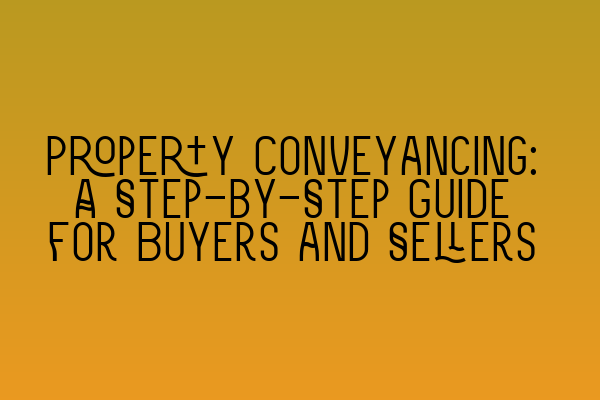Property Conveyancing: A Step-by-Step Guide for Buyers and Sellers
Are you planning to buy or sell a property? If so, you will need to navigate the intricate process of property conveyancing. This step-by-step guide will walk you through the entire process, ensuring you have a smooth and hassle-free experience. Whether you are a first-time buyer or an experienced seller, this guide will provide you with valuable insights and information. So, let’s dive in!
Step 1: Engage a Solicitor
The first and most crucial step in the property conveyancing process is to engage a solicitor. A solicitor specializing in property law will be your trusted advisor throughout the entire process. They will handle all the legal aspects, including contract preparation, property searches, and liaising with the other party’s solicitor.
Step 2: Pre-Contract Stage
Once you have engaged a solicitor, they will begin the pre-contract stage. This involves gathering necessary information such as the property title deeds, planning permissions, and any other relevant documentation. Your solicitor will also conduct searches to ensure there are no issues with the property, such as outstanding loans or disputes.
Step 3: Drafting and Negotiating the Contract
With all the necessary information at hand, your solicitor will draft the contract. This is a legally binding document that outlines the terms and conditions of the property transaction. Once the contract is drafted, it will be sent to the other party’s solicitor for review and negotiation. This process may involve multiple rounds of back-and-forth until both parties agree on the terms.
Step 4: Exchange of Contracts
Once the contracts are finalized and all parties are satisfied, the next step is the exchange of contracts. This is when the buyer and seller sign their respective contracts and swap them. At this stage, both parties are legally bound to proceed with the transaction. The buyer will also pay a deposit, usually 10% of the property price, which is held by the seller’s solicitor.
Step 5: Completion
Completion is the final and most exciting step in the conveyancing process. On the agreed completion date, the buyer’s solicitor will transfer the remaining funds to the seller’s solicitor. Upon receipt of the funds, the seller’s solicitor will confirm the completion and release the keys to the buyer. Congratulations, you are now the proud owner of a new property!
Step 6: Post-Completion
Even after completion, there are a few post-completion tasks that need to be addressed. These include registering the property with the Land Registry, transferring utility accounts, and updating your address with relevant authorities. Your solicitor will guide you through these tasks, ensuring a seamless transition into your new home.
In conclusion, property conveyancing is a complex process that requires expertise and attention to detail. By engaging a solicitor specializing in property law, you can navigate the process with confidence. Remember to stay informed, ask questions, and rely on your solicitor’s expertise. Happy buying or selling!
If you want to streamline your preparation for the SQE exams, consider checking out our related articles:
– SQE 1 Practice Exam Questions: Click Here
– SQE 1 Practice Mocks FLK1 FLK2: Click Here
– SQE 2 Preparation Courses: Click Here
– SQE 1 Preparation Courses: Click Here
– SRA SQE Exam Dates: Click Here
These resources will help you prepare effectively, ensuring success in your SQE exams. Good luck on your journey towards becoming a qualified solicitor!
